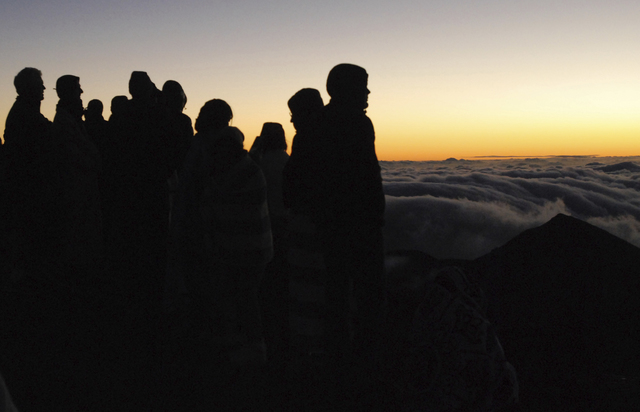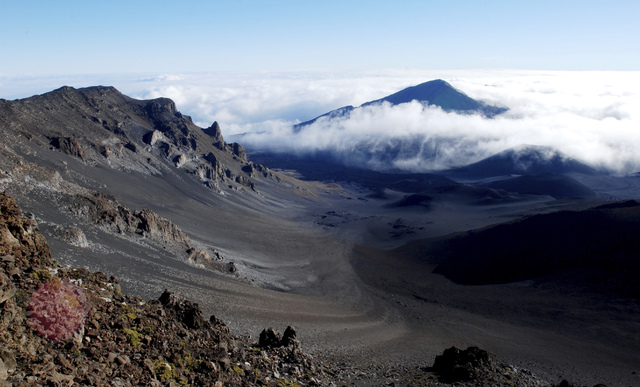New rules curb Haleakala sunrise crowd

ASSOCIATED PRESS
People gather ahead of the sunrise each morning on the summit of Haleakala volcano in Haleakala National Park on Maui, above. As a result of the increase in visitors that create a safety hazard, anyone wanting to see the sunrise on the summit is now required to make reservations in advance and pay a small fee.

ASSOCIATED PRESS
Clouds hang below the summit of Haleakala volcano in Haleakala National Park.


HALEAKALA NATIONAL PARK, Maui >> Well before dawn each morning, throngs of tourists from around the world make their way to Maui’s tallest peak, a dormant volcano, to see what Mark Twain called the “sublimest spectacle” he ever witnessed.
They drive up a long, winding road through clouds to an otherworldly, lava-rock landscape at 10,000 feet. Then they bundle up and take their place for a dazzling daybreak show.
“Just the sunrise from the top of the world — it’s pretty remarkable and incomparable,” Julia Grant of Mission, British Columbia, said on a recent visit after watching the sun peek out from the horizon and saturate the sky in endless shades of yellow, orange and red.
Over the past year the sunrise view from atop Haleakala — Hawaiian for “house of the sun” — has been attracting more than 1,000 people a day. The result, officials say, was a logjam of cars spilling out of the parking lots and onto the road, creating a safety hazard, and footsteps trampling sensitive habitat.
To address the problem, the National Park Service last week started requiring reservations and limiting the number of vehicles to the available parking spots, potentially cutting in half the number of early-morning visitors.
Sunrise viewing has long been popular at Haleakala, one of the main attractions at Haleakala National Park, despite morning temperatures that often dip into the 30s. Red soil and lava rocks dominate the summit, and only a few hearty plants have adapted to the harsh, high-altitude conditions.
Don't miss out on what's happening!
Stay in touch with breaking news, as it happens, conveniently in your email inbox. It's FREE!
The peak also is home to the nene, the Hawaiian goose, and colonies of spiders that feast on bugs blown in from the surrounding wilderness.
Overcrowding started becoming a problem roughly 15 years ago, park Superintendent Natalie Gates said. About a year ago it got worse, likely as more people learned about the stunning sunrise views from images shared on social media.
“If you ever went up there, you would see that fully half to three-quarters of our visitors who are watching the sunrise are either taking photos that they immediately broadcast to their friends or filming it,” Gates said.
The area at and near the summit has 150 parking spaces, but before the new system took effect, more than 300 rental cars and other vehicles often crammed onto Haleakala at daybreak. Drivers who couldn’t find a spot would park on the side of the road or on the road itself, blocking the way for emergency responders.
Though only 16 percent of park visitors come at sunrise, they account for 40 percent of the park’s emergency medical calls.
“It’s a dark place. It’s rocky. And when people are moving away from crowds and trying to go off trail, often frequently stumbling around on cliff sides in the dark, we see trauma cases, altitude cases,” Gates said. “We sometimes see cardiac and other cases.”
Straying humans also tread on seedlings and root systems of the Haleakala silversword, a rare, bushlike plant with thick leaves. And they can disturb the ground nests of the Hawaiian petrel, an endangered seabird.
Under the new system, only those driving to the summit between 3 and 7 a.m. need reservations, which cost $1.50 per car plus the $20 park entrance fee.
The system closes to sunrise viewers after the allotted 150 vehicles per morning have made their reservations. The proceeds will pay for administering the reservation program. People on guided tours won’t be affected, as tour companies fall under different regulations.
Reservations can be made up to two months in advance at the website recreation.gov Opens in a new tab.
The change will require adjustments from people who don’t normally plan ahead, said Carol Clark, Maui Visitors and Convention Bureau spokeswoman. But her agency contends the benefits far outweigh any inconvenience.
8 responses to “New rules curb Haleakala sunrise crowd”
Leave a Reply
You must be logged in to post a comment.





A sensible plan. Let’s just make sure the reservations don’t start getting skimmed off by private groups like they were at Pearl Harbor.
should be free for kama’aina… just as hanauma bay is free for kama’aina. the feds would never go for that tho.
Willieboy as much as I agree with you it is another place in our islands that we have lost to tourism just like Hanauma Bay which was once a sweet place for local families, BBQ’s and grass area on the top for the kupuna who couldn’t make the walk down. Even the fish are running away from Hanauma, get too many tourists.
A-Reader, Unfortunately Hawaii can’t survive without tourism.
As a kid I’ve been up to Haleakala several times, though never at sunrise. It was always a good experience with the cool weather, volcanic landscape, Nene and silverswords. I just don’t get the allure of waking up early, battling the crowds, just to see the sun rise. A sunrise while on board a plane is probably just as spectacular.
…and to beat the new system, just arrive at the park at 0200.
Why the extra fee? I regularly witness similar overcrowding at other National Parks, most notably Yellowstone, Grand Teton, and Zion National Parks. In the case of Zion, the overcrowding has forced park management to institute a shuttle bus system to deal with the traffic congestion caused by overwhelming numbers of visitors. In NONE of these parks are there extra fees imposed. Why Haleakala? I think this is nothing more than an attempt to wring ever more money from the pockets of park-lovers, both residents and non-residents. Apparently, it’s a lot easier for National Park management at Haleakala to impose more fees than to add more visitor parking. This ain’t rocket science, people. If you’re going to charge extra fees, then take that money and do some good with it: Add more parking instead of shutting people out, some of whom have travelled from the farthest reaches of the globe to experience Sunrise at Haleakala. Really, how unimaginative can you get?
unimaginative?
imagine the protests from hawhiners if the park were to start constructing parking lots or allowing bus convoys up the sacred rock pile.